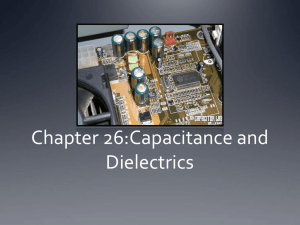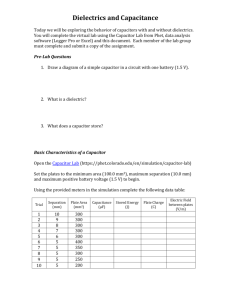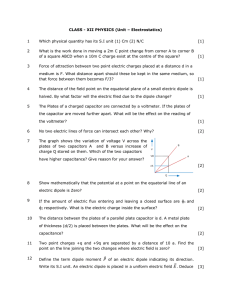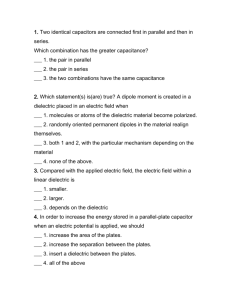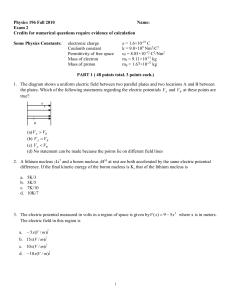26 Capacitance-2:
advertisement
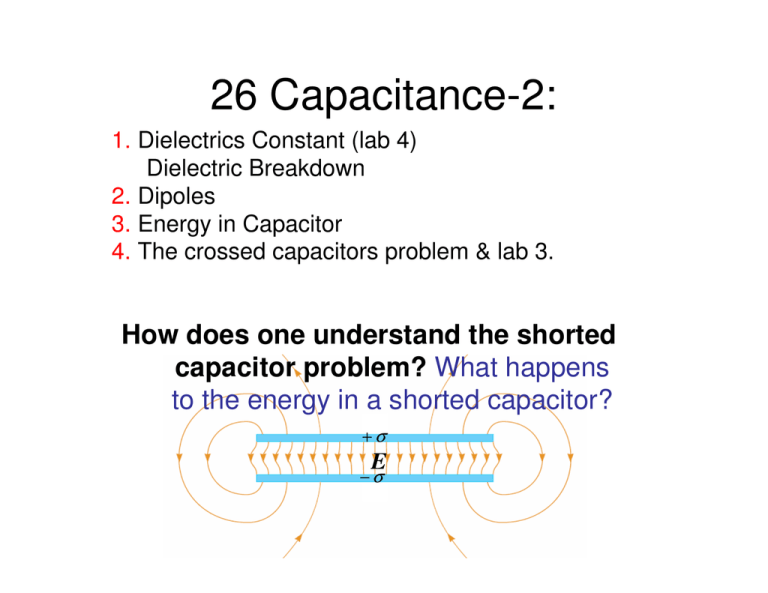
26 Capacitance-2: 1. Dielectrics Constant (lab 4) Dielectric Breakdown 2. Dipoles 3. Energy in Capacitor 4. The crossed capacitors problem & lab 3. How does one understand the shorted capacitor problem? What happens to the energy in a shorted capacitor? +σ E −σ iClicker Quiz I have completed at least 50% of the reading and study-guide assignments of Chapters 26:4-6 A. True B. False Today pay attention to: 1. Dielectrics: What do they do in Caps and how do they do it? 2. A dipole points from the minus to the plus. When is the max torque? When are the maximum & minimum energy? 3. Mind the ½ in equations for energy. 4. Two elements are in parallel if they have the same voltage “drop” across them. In the crossed capacitor problem, are the two circuit elements in series or parallel? (This is sections 26.2, 26.3, 26.6 & 26.7 of Ch. Sum.) Calendar: HW 11 due Tuesday 8:45 a.m. 1. Exam 2 is in boxes. Yes, it was tough. Let’s talk. 2. Labs 3 & 4 are due in a 7 days. First question: • Why don’t commercial capacitors look like plates from the outside. First question: Why don’t commercial capacitors look like plates from the outside? Types of Capacitors – Tubular •Metallic foil may be interlaced with thin sheets of paraffinDielectrics impregnated paper or Mylar. •The layers are rolled into a cylinder to form a small package for the capacitor. Section 26.5 Capacitors with Dielectrics • A dielectric is a nonconducting material that, when placed between the plates of a capacitor, increases the capacitance. – • With a dielectric, the capacitance becomes C = κCo. – – • • Dielectrics include rubber, glass, and waxed paper The capacitance increases by the factor κ when the dielectric completely fills the region between the plates. κ is the dielectric constant of the material. Sometimes we slide a dielectric into a capacitor. What happens? 1st case: While you slide an insulator between the plates of a fully charged capacitor on a battery, the voltage of the capacitor: A. Decreases B. Increases C. Stays the same Section 26.5 Capacitors with Dielectrics •A dielectric is a nonconducting material that, when placed between the plates of a capacitor, increases the capacitance. – Dielectrics include rubber, glass, and waxed paper •With a dielectric, the capacitance becomes C = κCo. – The capacitance increases by the factor κ when the dielectric completely fills the region between the plates. – κ is the dielectric constant of the material. •Sometimes we slide a dielectric into a capacitor. What happens? – If the capacitor remains connected to a battery, the voltage across the capacitor necessarily remains the same & Q goes up. – If the capacitor is disconnected from the battery, the capacitor is an isolated system & the charge remains the same & V goes down. Section 26.5 Tricky Review question: While you slide an insulator between the plates of a fully charged capacitor on a battery, the q of the capacitor A. Decreases B. Increases C. Stays the same Dielectrics & Big Capacitances •For a parallel-plate capacitor, C = κ(εoA) / d •In theory, d could be made very small to create a very large capacitance. •In practice, there is a limit to d. –d is limited by the electric discharge that could occur though the dielectric medium separating the plates. •For a given d, the maximum voltage that can be applied to a capacitor without causing a discharge depends on the dielectric strength of the material. Section 26.5 Review Quiz: T/F The dielectric constant is the ability of an insulator to not have a spark penetrate it in high electric fields. A is true, B false. Dielectrics, Summary •Dielectrics provide the following advantages: –Increase in capacitance –Increase the maximum operating voltage –Possible mechanical support between the plates • This allows the plates to be close together without touching. • This decreases d and increases C. Section 26.5 54 a. What equation do we use in chapter summaries? Talk to friend or remember b. Do we have enough info here to do part b? True A or False B pp. Some Dielectric Constants and Dielectric Strengths Section 26.5 54 b. Now we have enough info here to do parts b. While you slide an insulator between the plates of a fully charged capacitor disconnected from a battery, the q of the capacitor A. Decreases B. Increases C. Stays the same c. What happens to the voltage? A. Decreases B. Increases C. Stays the same What equation do we use to show this? Types of Capacitors – Oil Filled •Common for highvoltage capacitors •A number of interwoven metallic plates are immersed in silicone oil. Section 26.5 Types of Capacitors – Electrolytic •Used to store large amounts of charge at relatively low voltages •The electrolyte is a solution that conducts electricity by virtue of motion of ions contained in the solution. •When a voltage is applied between the foil and the electrolyte, a thin layer of metal oxide is formed on the foil. •This layer serves as a dielectric. •Large values of capacitance can be obtained because the dielectric layer is very thin so the effective plate separation, d, is very small. Section 26.5 Types of Capacitors – Variable •Variable capacitors consist of two interwoven sets of metallic plates. – One plate is fixed and the other is movable. – Contain air as the dielectric •These capacitors generally vary between 10 and 500 pF. •Used in tuning circuits in old style radios. Section 26.5 ε 0 → ε = κε 0 , κ > 1 Dielectric materials contain polar molecules that can align with an external field. The field produced by these dipoles gets added to the external field. water The dissectible capacitor Involves corona discharge to the plastic glass as it is disassembled. Electric Dipole •An electric dipole consists of two charges of equal magnitude and opposite signs. •The charges are separated by 2a =d. •The electric dipole r moment ( p ) is directed along the line joining the charges from –q to +q. Section 26.6 Electric Dipole, 2 •The electric dipole moment has a magnitude of p ≡ 2aq. •Assume the dipole is placed in a uniform external field, Er – r E is external to the dipole; it is not the field produced by the dipole •Assume the dipole makes an angle θ with the field Section 26.6 Electric Dipole in a UNIFORM E field •Each charge has a force of F = Eq acting on it. •The net force on the dipole is zero. •The forces produce a torque on the dipole. •The dipole is a rigid object so it experiences only a torque. Section 26.6 Dipoles: consider the following collection of dipoles in a uniform electric field. At the time we see them they are clamped in place. When they are released how many of them feel a net force? Dipoles: consider the following collection of dipoles in a uniform electric field. At the time we see them they are clamped in place. When they are released how many of them want to turn clockwise? Electric Dipole, final •The magnitude of the torque is: t = 2Fa sin θ = pE sin θ •The torque can also be expressed as the cross product of the moment and the field: r r r τ = p×E •The system of the dipole and the external electric field can be modeled as an isolated system for energy. •The potential energy can be expressed as a function of the orientation of the dipole with the field: Uf – Ui = pE(cos θi – cos θf) ® U = - pE cos θ This expression can be written as a dot product. Section 26.6 What is the maximum energy a dipole can have in Field E? A. pE B. ½pE C. zero. D.-pE E.-½pE What direction does it face at maximum? What is the minimum energy a dipole can have in Field E? A. pE B. ½pE C. zero. D.-½pE E.-pE The eqn. for a dipole is p=2aq. We have q, how do we get 2a? d) What is the maximum & minimum energy a dipole can have in Field E? Energy in a Capacitor – Overview •Consider the circuit to be a system. •Before the switch is closed, the energy is stored as chemical energy in the battery. •When the switch is closed, the energy is transformed from chemical potential energy to electric potential energy. •The electric potential energy is related to the separation of the positive and negative charges on the plates. •A capacitor can be described as a device that stores energy as well as charge. Section 26.4 Energy Stored in a Capacitor: U= ½Q∆V •Assume the capacitor is being charged and, at some point, has a charge q on it. •The work needed to transfer a charge from one plate to the other is dW = ∆Vdq = q dq C •The incremental work required is the area of the tan rectangle. •The total work required is W =∫ Q 0 q Q2 dq = C 2C Section 26.4 Energy, con’t •The work done in charging the capacitor appears as electric potential energy U: Q2 1 1 U= = Q∆V = C( ∆V )2 2C 2 2 •This applies to a capacitor of any geometry. •The energy stored increases as the charge increases and as the potential difference increases. •In practice, there is a maximum voltage before discharge occurs between the plates. Breakdown Section 26.4 Energy density in an electric field: a very important concluding remark. Potential difference: V The energy can be considered to be stored in the electric field. E 2 2 2 CV (ε 0 A / d )V Energy V 1 1 u= = = = 2 ε0 = 2 ε0E2 Volume Ad Ad d 1 2 1 2 Adding a dielectric to any situation ε 0 → ε = κε 0 C ppc 1 2 Aε Aκε 0 = = d d 2 1 2 u = ε E = κε0 E Φ = ∫ E ⋅ dA = Q ε = 2 Q κε 0 Some Uses of Capacitors •Defibrillators –When cardiac fibrillation occurs, the heart produces a rapid, irregular pattern of beats –A fast discharge of electrical energy through the heart can return the organ to its normal beat pattern. •In general, capacitors act as energy reservoirs that can be slowly charged and then discharged quickly to provide large amounts of energy in a short pulse. Section 26.4 What is the first steps to do part a? A. Get the equation U=-p●E and find p and E B. Add C1 and C2 together to get C & Use U= ½ CV². C. Use U= ½ CV² & add 1/C1 and 1/C2 together to get 1/C. D. Calculate the Q in each capacitor, sum them and use U= ½ CQ² We have talked about several geometries and resultant formulae. Which one do we use here? We have talked about several geometries and resultant formulae. Which one do we use here? Q l C= = ∆V 2ke ln ( b / a ) A. C. C = κε0 A/d Q ab C= = ∆V ke ( b − a ) B. Why? D. C = 4πκε0a We will do this problem another time. The crossed capacitor problem: Crossed capacitor problem + + − − C1 Q1 = C1V1 V '= V2 Q2 = C2V2 + + − − C1 Q1 = C1V1 + + C2 − − Q2 = C2V2 Q' Q1 − Q2 = C ' C1 + C2 C1 C2 + + − − C1 Q1 = C1V1 Q'1 = C1V ' Q'2 = C2V ' C2 + + − − V1 + + C2 − − Q2 = C2V2 Suppose you do the same thing without crossing them. + + − − C1 V1 Q1 = C1V1 V '= + + C2 − − V2 Q2 = C2V2 + + − − C1 Q1 = C1V1 + + C2 − − Q2 = C2V2 Q' Q1 + Q2 = C ' C1 + C2 C1 C2 + + − − C1 Q1 = C1V1 Q'1 = C1V ' Q'2 = C2V ' + + C2 − − Q2 = C2V2 Crossed capacitor problem: special case where V1 = V2 + + − − C1 V Q1 = C1V Q2 = C2V Q1 = C1V + + C2 − − Q2 = C2V C − C2 Q' Q1 − Q2 = = V 1 C ' C1 + C2 C1 + C2 C1 C2 + + − − C1 Q1 = C1V Q'1 = C1V ' Q'2 = C2V ' C2 + + − − V '= + + − − C1 + + C2 − − Q2 = C2V Polar vs. Nonpolar Molecules •Molecules are said to be polarized when a separation exists between the average position of the negative charges and the average position of the positive charges. •Polar molecules are those in which this condition is always present. •Molecules without a permanent polarization are called nonpolar molecules. Section 26.6 Water Molecules •A water molecule is an example of a polar molecule. •The center of the negative charge is near the center of the oxygen atom. •The x is the center of the positive charge distribution. Section 26.6 Polar Molecules and Dipoles •The average positions of the positive and negative charges act as point charges. •Therefore, polar molecules can be modeled as electric dipoles. Section 26.6 Induced Polarization •A linear symmetric molecule has no permanent polarization (a). •Polarization can be induced by placing the molecule in an electric field (b). •Induced polarization is the effect that predominates in most materials used as dielectrics in capacitors. Section 26.6 Dielectrics – An Atomic View •The molecules that make up the dielectric are modeled as dipoles. •The molecules are randomly oriented in the absence of an electric field. Section 26.7 •An external electric field is applied. •This produces a torque on the molecules. •The molecules partially align with the electric field. – The degree of alignment depends on temperature and the magnitude of the field. – In general, the alignment increases with decreasing temperature and with increasing electric field. Dielectrics – An Atomic View, 2 Section 26.7 Dielectrics – An Atomic View, 4 •If the molecules of the dielectric are nonpolar molecules, the electric field produces some charge separation. •This produces an induced dipole moment. •The effect is then the same as if the molecules were polar. Section 26.7 Dielectrics – An Atomic View, final •An external field can polarize the dielectric whether the molecules are polar or nonpolar. •The charged edges of the dielectric act as a second pair of plates producing an induced electric field in the direction opposite the original electric field. Section 26.7 Induced Charge and Field •The net effect on the dielectric is an induced surface charge that results in an induced electric field. •The electric field due to the plates is directed to the right and it polarizes the dielectric. •If the dielectric were replaced with a conductor, the net field between the plates would be zero. Section 26.7
